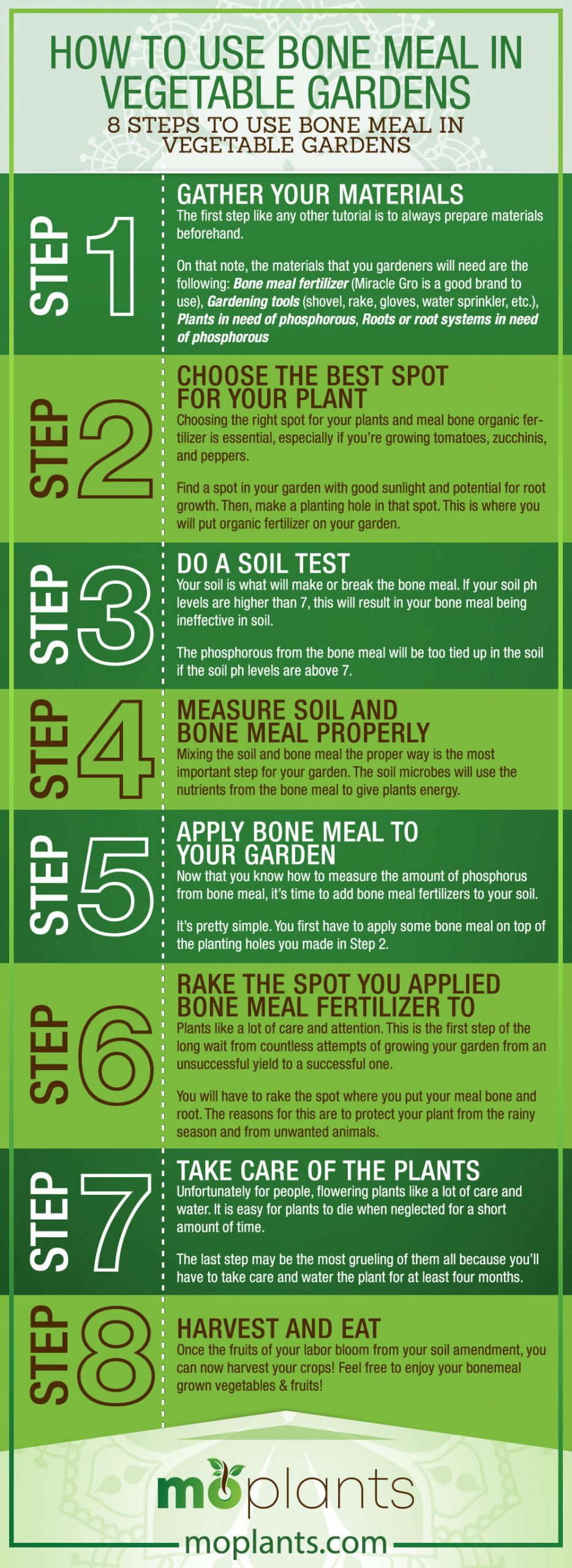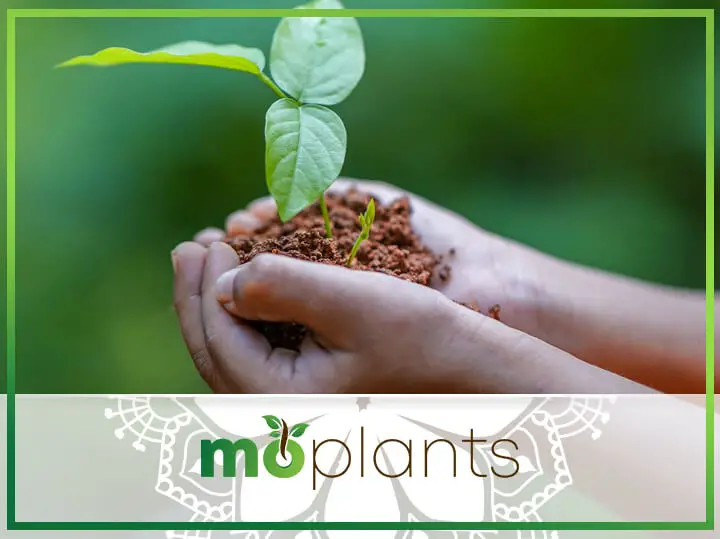The soil is what will make or break your garden work. If it mixes with the proper garden fertilizer, then it will yield good ingredients for you in the future.
With that, let’s take a look at how to use a bone meal in vegetable gardens – one of the best organic fertilizers for your garden soil!
8 Steps to Use Bone Meal in Vegetable Gardens
Step 1: Gather Your Materials
Greetings, gardeners!
The first step like any other tutorial is to always prepare materials beforehand.
On that note, the materials that you gardeners will need are the following:
- Bone meal fertilizer (Miracle Gro is a good brand to use)
- Gardening tools (shovel, rake, gloves, water sprinkler, etc.)
- Plants in need of phosphorous
- Roots or root systems in need of phosphorous
Step 2: Choose the Best Spot for Your Plant
Choosing the right spot for your plants and meal bone organic fertilizer is essential, especially if you’re growing tomatoes, zucchinis, and peppers.
Find a spot in your garden with good sunlight and potential for root growth. Then, make a planting hole in that spot. This is where you will put organic fertilizer on your garden.
Step 3: Do a Soil Test
Your soil is what will make or break the bone meal. If your soil ph levels are higher than 7, this will result in your bone meal being ineffective in soil.
The phosphorous from the bone meal will be too tied up in the soil if the soil ph levels are above 7.
You can lower the soil ph level by adding aluminum sulfur or sulfate. Be careful though, as these chemicals can burn through your flowering plants and flowers if spilled on.
Once your soil ph level is below 7, you’re one step closer to having successful fruit and vegetable yields.
Step 4: Measure Soil and Bone Meal Properly
Mixing the soil and bone meal the proper way is the most important step for your garden. The soil microbes will use the nutrients from the bone meal to give plants energy.
Results will differ if you put too much bone meal on your soil. If you put too much phosphorous or bone meal organic fertilizer, your plants will have less chlorophyll production.
This surplus of soil amendments will turn the leaves of your plant yellow.
On the other hand, if your source of phosphorus is too little, your plant roots will not have enough of the nutrient it needs to grow flowers or fruits.
The lack of phosphorus will not make it easy for the root of your plants to grow and develop fruits.
The right amount of bone meal fertilizer to put on your garden soil is 10 pounds per square feet. For large-scale organic gardening, you can choose to use 1000 pounds for 100 square feet.
Buying 1000 pounds of bone meal fertilizer for 100 square feet will hurt a bit financially. But, imagine all the beautiful crops you can get from your plants and sell someday!
Step 5: Apply Bone Meal to Your Garden
Now that you know how to measure the amount of phosphorus from bone meal, it’s time to add bone meal fertilizers to your soil.
It’s pretty simple. You first have to apply some bone meal on top of the planting holes you made in Step 2.
After adding bone meal to the holes, you put the roots of the plants you want to grow on top of the bone meal fertilizer.
Next, you bury all the roots using soil.
Finally, you put a little more bone meal on top of the soil. Make sure you’re adding bone meal fertilizer at the right total amount, 10 pounds per square feet, for your plants.
Step 6: Rake the Spot You Applied Bone Meal Fertilizer To
Plants like a lot of care and attention. This is the first step of the long wait from countless attempts of growing your garden from an unsuccessful yield to a successful one.
You will have to rake the spot where you put your meal bone and root. The reasons for this are to protect your plant from the rainy season and from unwanted animals.
Step 7: Take Care of the Plants
Unfortunately for people, flowering plants like a lot of care and water. It is easy for plants to die when neglected for a short amount of time.
The last step may be the most grueling of them all because you’ll have to take care and water the plant for at least four months.
After the four months or the growing season, the soil amendments would have finished releasing the phosphorus into the roots.
This slow release of phosphorus may take very long, but it’s worth it if you want your garden crops, fruits, vegetables, or flowers to grow properly.
Step 8: Harvest and Eat
Once the fruits of your labor bloom from your soil amendment, you can now harvest your crops! Feel free to enjoy your bonemeal grown vegetables & fruits!
Infographic

Bone Meal Fertilizers: What You Need to Know
Bone meal fertilizer is a powdered substance made out of pulverized animal bones. Not to worry though, because these animal bones were cleaned before getting crushed into a fine powder.
Most of the time, bonemeal comes from beef bones. But aside from beef bones, bonemeal can also come from other types of bones, like fish.
Overall, bonemeal fertilizer is full of nutrients that will help your plants with their nutrient deficiencies.
Why Use Bone Meal Fertilizers For Your Plants?
Bone meal Fertilizer, when mixed with soil, will help give the proper nutrients to plants with phosphorus deficiency.
So if you want the root of your plant to grow and yield rich produce, use bone meal.
Adding bone meal to the soil of your plant will give it a great source of phosphorus and calcium. But since most rely on bone meal more for its phosphorus, that is what we will focus on.
What Is Phosphorus?
Phosphorus is a nutrient that makes up 1% of the body weight of people and animals.
Phosphorus is in the teeth and bones of people and animals. It is also responsible for making protein for body growth and maintenance.
What Is the NPK Balance?
Phosphorus is the “P” in the NPK Balance. The NPK balance is a value that represents the macro-nutrients that plants need from a fertilizer.
NPK Balance:
- N = Nitrogen
- P = Phosphorus
- K = Potassium
These macro-nutrients all do different things for plants.
- Nitrogen helps the leaves of plants grow.
- Phosphorus helps the root of the plant grow, while also aiding in fruit development.
- Potassium helps the plant perform smoothly.
The NPK balance gives out 3 numbers and each number corresponds to the 3 letters. So for example, the NPK of bone meal is 3-15-0. While the NPK of blood meal is 12-0-0.
What this means is blood meal has 3 times more nitrogen than a bone meal. But apart from nitrogen, it does not offer any other macro-nutrient in the NPK balance.
Bone meal, on the other hand, is a great source of phosphorus because its NPK balance is 3-15-0.
The bone meal also has less nitrogen compared to the blood meal. Bones meal also does not contain potassium.
People will need the information about the NPK balance to understand which nutrient their plants need.
You can search for the information about the NPK balance of a fertilizer in their packages or you can also search for the information of a fertilizer online.
If you’re having trouble finding this information, you can always search for related articles about gardening, soil, and fertilizers online.
Is Using Bone Meal Fertilizer Safe?
The biggest fear of people is getting mad cow disease or bovine spongiform encephalopathy if you add bone meal fertilizer to your soil.
Mad cow disease is a fatal disease for cattle.
However, there have been some cases where people have gotten the human form of mad cow disease called Creutzfeldt-Jakob disease.
The chances of getting mad cow disease from bone meal are slim to none. The animals used for bone meal are all tested beforehand. If an animal tests positive, it will not be used.
Also, the powdering procedure that the bones of the animal go through will kill off any pathogen.
Tips for Using Bone Meal Fertilizer
Mix Properly Before Using
Don’t just drop your bone meal on the soil. Make sure to properly measure the amount of bone meal needed and follow step 5.
Read Before Applying
always read the information from the packaging of your bone meal before using it.
Since bone meal brands vary, the amount of fertilizer you put on your soil are also different. Understand the measurements of the bone meal brand you have first, then apply it to your garden.
Store Away From Pets
Though bone meal is safe for humans, it may have a negative effect on your pets. Ingesting bone meal may cause your pet to have a blockage in his/her gastrointestinal tract.
This obstruction will require surgery for removal. So, make sure bone meal is not part of your dog’s menu.
Wear Gloves
If you’re afraid of getting sick using bone meal fertilizer, then you should wear gloves.
Gloves will protect you from any sickness that your soil may give you. It will also be able to keep your hands clean as you harvest your garden.
Conclusion
Understanding how to use bone meal fertilizer is a great way to improve your garden. Using it the right way will give your plants a higher chance to bloom, while also strengthening their root systems.
Now that you know what you need to know about bone meal, it’s time for you to use bone meal fertilizer in your garden!
We hope this article was able to help you learn how to use bone meal effectively for better yield results! Feel free to leave us comments in the section below.


